To some of us, one of the biggest pleasures, next to the ride itself, is quantifying the vast amount of data available to us about our performance. The prevalence of GPS based and downloadable cycling computers, combined with various websites and programs have made it possible to catalog, view and analyze mountains of data; metrics from average pace to peak wattage vs. peak heart rate are now at your fingertips. Here's a quick overview of a couple of the more common (and interesting) sites/programs out there.
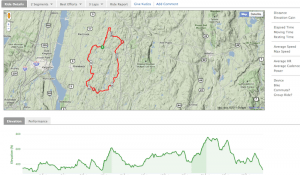
Strava
Strava.com is the relative new kid on the block in terms of ride analysis. Offering both free and subscription services ($6 per month or $59 per year) will allow riders the ability to directly upload rides from their GPS devices (Garmin Communicator doesn't work in Chrome though…) and track their performance. Displaying a GPS track of the route you rode, along with an elevation profile and metrics such as distance, elevation gain, moving time, speed (max and average), average speed, average cadence and average power, you get a full battery of information to sift through and analyze.
One of the coolest features of Strava, and perhaps what sets it apart and is a major part of its appeal is the community aspect of it. You can link Strava to your Facebook page to post your rides on your Facebook wall, and you can even challenge friends (or strangers for that matter) to competitions. You see, Strava has a unique feature that allows you to designate segments (climbs, TTs, whatever) that you can measure against other member's performances. It's an excellent idea that promotes competition and growth amongst different riders all riding in the same area.
For example, imagine your club has a friendly “climbing competition” up a particularly long, steep, or otherwise nasty climb. Anyone who is a member of Strava who uploads a ride containing that climb will be ranked based upon speed, power, time and VAM (Vertical Ascent Meters) along with everyone else who has ridden that climb. The best part of the whole thing is that once the climb is designated on Strava, the site software automatically finds that segment of your ride and analyzes it, compares it to everyone else, and posts it in ranking of fastest to slowest. It's an excellent tool to use to compare both your form compared to others around you, and to chart your own progress by comparing to your previous attempts.
Add to those features the ability to join your club on their own club page and take part in various competitions (posted by the site managers or your own club manager) and you have the perfect breeding ground to motivate you into improving your form.
PROS: Great community based concepts. “Segments” option for competing with your friends. Excellent data presentation and layout.
CONS: Pay site is yet another expense (free site only 5 rides/month allowance), not a huge community following at the present time, does not offer true analysis of ride data.
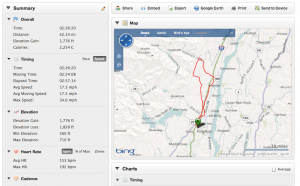 Garmin Connect
Garmin Connect
The online utility that appears to have replaced Garmin Training Center (which, let's face it, was pretty much worthless anyway) is a big improvement over the software which it replaced. Allowing direct upload from a GPS device (again, make Garmin Communicator work in Chrome please) and displaying large amounts of data in easy to read formats are huge plusses for this site.
The main feature of Garmin Connect lies in the GPS map display and all the data that was logged during the ride. It is all displayed in a very neat, pleasing manner which is simple to navigate and analyze. There are several tabs for adjusting your view from speed to pace and adjusting your heart rate data display from absolute to %max to zones. Additionally, the map is fully interactive and you can see your data from various points on the map by following the track outline.
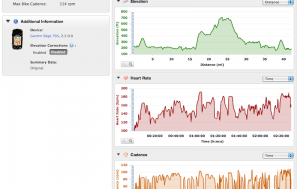 Not only does Connect give you raw numbers to look at, it also adds several neatly rendered graphs that will chart elevation, heart rate, cadence and pacing all in relation to a number of benchmarks (time, distance, etc.) This can be very handy to look at trends in your riding, where you can improve or where you're already strong and don't need to work on. In addition to all these features, you can also share your rides, imbed them on websites, export files to your GPS unit and view routes in 3D Google Earth. And most interestingly, there is a playback function that allows you follow your ride in a sped up fashion to see how you rode the route in question.
Not only does Connect give you raw numbers to look at, it also adds several neatly rendered graphs that will chart elevation, heart rate, cadence and pacing all in relation to a number of benchmarks (time, distance, etc.) This can be very handy to look at trends in your riding, where you can improve or where you're already strong and don't need to work on. In addition to all these features, you can also share your rides, imbed them on websites, export files to your GPS unit and view routes in 3D Google Earth. And most interestingly, there is a playback function that allows you follow your ride in a sped up fashion to see how you rode the route in question.
PROS: Free site, large amounts of data processing, ability to virtually “play back” a ride and watch it.
CONS: Not the greatest analysis software for making substantial improvements, somewhat limited in scope as more of a file storage than pure analysis site.
Training Peaks
Training Peaks can really be separated into two separate entities: Trainingpeaks.com and WKO+. Trainingpeaks.com is a web based fitness and training monitor that tracks everything from fitness trends to stress scores, meal plans and coaching. There are free versions and paid versions, as well as individual training plans available for purchase from noted coaches such as Hunter Allen and Joe Friel.
While the .com version of Training Peaks is a very solid training tool, I'll be honest in that I have pretty much no experience with it, so I'lm going to limit my commentary on it here. For the most part, I utilize WKO+ which is a downloadable software bundle that can integrate into Trainingpeaks.com and work simultaneously with it, or on its own. Personally, I utilize WKO+ on its own with no problems, and it works flawlessly.
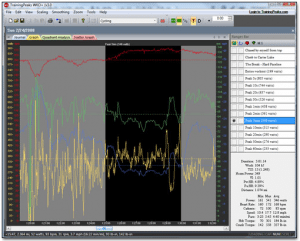 Training Peaks WKO+ is a pricey software package (at $129 for new users) but there are some discounts available to USA cycling members and others. You will also need to utilize a power meter of some kind to get the most of of WKO+ and make it worth the investment, but the amount of data that can be analyzed is phenomenal. By plotting and displaying nearly every metric you could ask for, from crank torque to average heart rate, WKO gives huge amounts of quantifiable data to analyze. You can analyze individual rides, the past week, the past month, or the entire season through numerous graphs and charts, all designed to help you maximize your performance and improvement.
Training Peaks WKO+ is a pricey software package (at $129 for new users) but there are some discounts available to USA cycling members and others. You will also need to utilize a power meter of some kind to get the most of of WKO+ and make it worth the investment, but the amount of data that can be analyzed is phenomenal. By plotting and displaying nearly every metric you could ask for, from crank torque to average heart rate, WKO gives huge amounts of quantifiable data to analyze. You can analyze individual rides, the past week, the past month, or the entire season through numerous graphs and charts, all designed to help you maximize your performance and improvement.
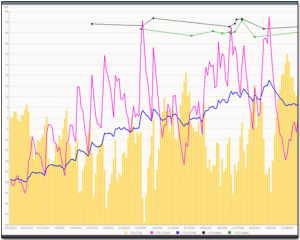
Perhaps one of the most useful features of WKO is the training stress metrics that will show how quickly and how much improvement is realized through your training methods. You can also follow peak power numbers from 1 second through 60 minutes to watch your wattage creep up (or not, if you're not training well.) Quadrant analysis will help you to determine the type of training you're doing, and if your training will translate well into the races on your calendar. Basically, with the proper analysis, every move you make as a cyclist can be read and analyzed to determine the cost/benefit of that move. It's the ultimate in training analysis.
PROS: Ultimate tool for training analysis, lots of support through trainingpeaks.com, free version of Trainingpeaks.com
CONS: WKO+ is Windows only (bummer if you're a Mac user), expensive (both premium website and WKO+), requires a power meter to reap the most benefit, no GPS map feature built into the software.
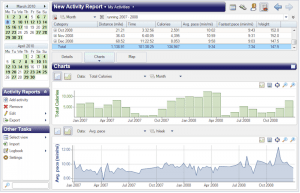 SportTracks
SportTracks
Zone Five Software came out with the SportTracks fitness utility several years ago. It is a wonderful tool that has huge potential for analyzing workout data, and I used it for that very purpose for a couple years before moving to WKO. The latest version really does force you to purchase a license, as the free version is somewhat limited.
SportTracks is probably the least intuitive software of the bunch, but it does have a lot of functionality built into it. The interface is dominated by a large GPS map of your route, and options are chosen by menu buttons on the top of the screen or the left side menu. You can directly download information from your GPS unit and display dozens of metrics, from heart rate average to (estimated) power averages for any part of the ride you choose.
The most interesting part of SportTracks is that it is essentially open source, in that programmers are constantly developing plugins for the software. These range from the popular “Elevation Correction” plugin to the “Estimated Power Plugin” which can extrapolate a rough wattage calculation out of your speed, cadence, grade, weather conditions and equipment choices. This extends the functionality of SportTracks far beyond the simple ride analysis and allows for a more in depth monitoring of your fitness levels, without the exorbitant price of a program like WKO+.
PROS: Plugin library allows you to customize SportTracks to your liking, reasonably cheap to upgrade to full version (about $40)
CONS: Windows only, somewhat cluttered and difficult to learn interface, some metrics NEED plugins for correction (elevation correction is a must)
Pick your poison
There are certainly a number of programs or sites that haven't been mentioned here: Golden Cheetah, RideWithGPS.com, MapMyRide.com, and plenty more. My suggestion for any of you looking for the mapping/analysis solution is to pick a program, download the trial versions and go to town. Get into understanding the quirks, the plusses and minuses of each, and then go from there. You may be surprised at what you find about your riding and your training.
Did I miss something critical? Disagree with something? Let me know with a comment below!

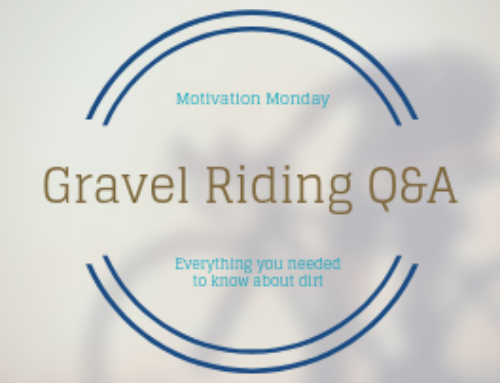
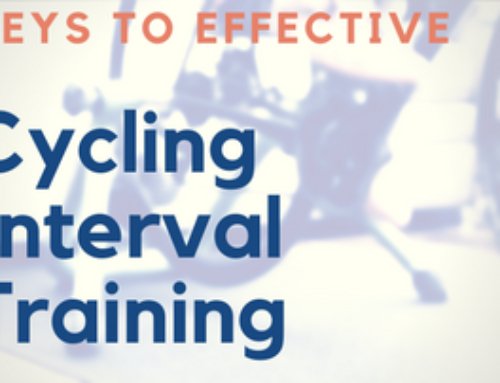



Strava also offers a free iPhone app if you don’t want to spring for a purpose-built GPS device.
http://itunes.apple.com/us/app/strava-cycling/id426826309?mt=8
I use Cycling Analytics as a cheaper option to TP. Not so complete as TP but covers every basic aspects of power analysis.
Interesting, I’ll have to take a look at it.
If you’re looking for free and with the same features as TrainingPeaks, you can check out Golden Cheetah as well. I use it for my power data tracking and client tracking as well. It has a wonderful free and very deep set of analysis tools.
Yes, I tried GC with my athletes but I couldn’t copy the settings to new profiles. Every new profile means that I had to do all the long process of customizing every tool, everything. For my non-powermeter athletes, browser-based Strava analysis still great!